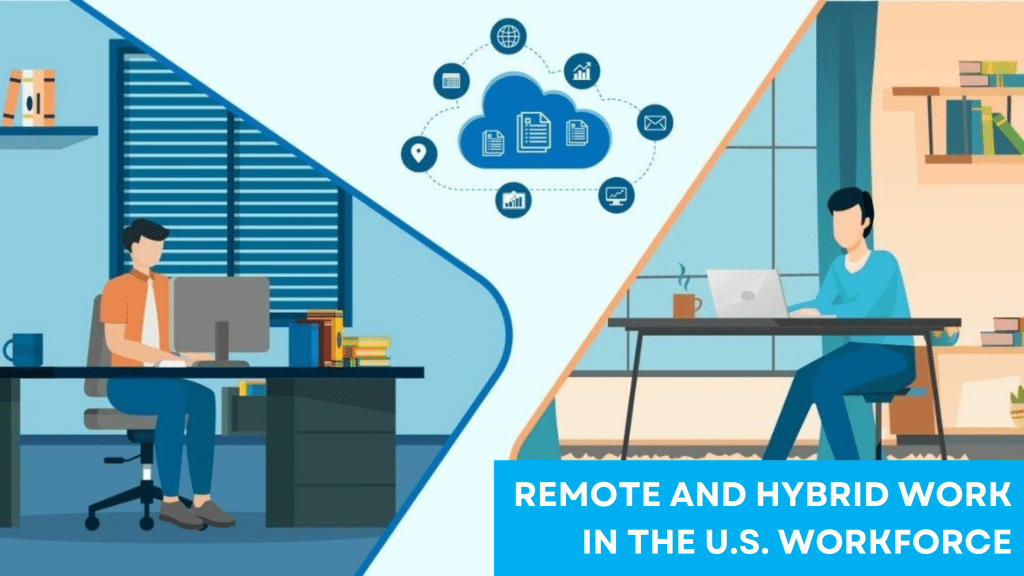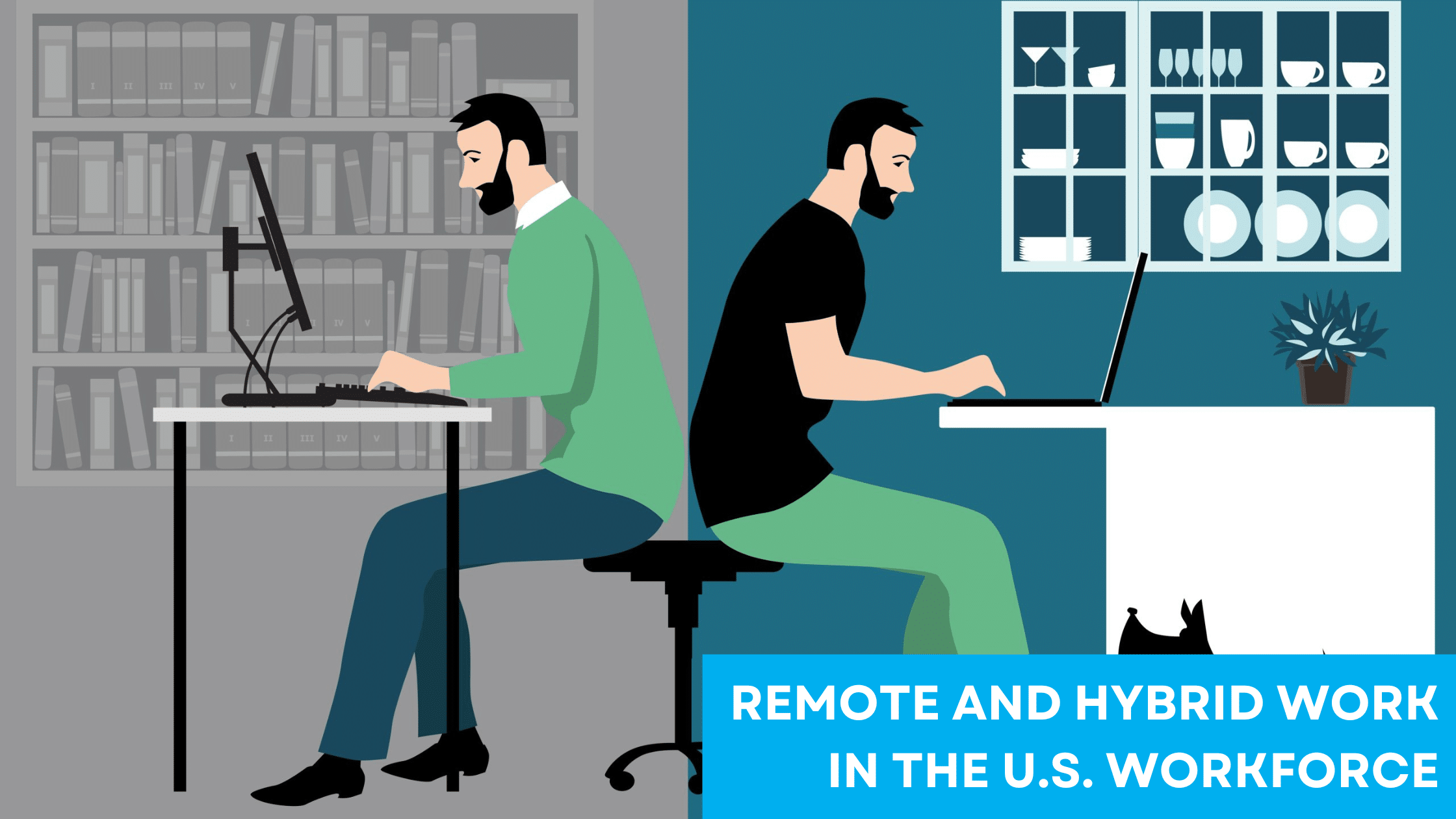Adoption Rates and Trends Among Employers
Remote/hybrid is widespread and stabilizing: After the 2020 spike in telework, hybrid arrangements have become the “new normal” for many organizations. Government data show that in early 2024, about one-quarter of U.S. workers (age 25+) were working from home at least some of the time (24.9%, up from 21.5% a year prior). Likewise, Gallup finds that among jobs that can be done remotely (“remote-capable” roles), only 20% remain fully on-site as of 2023. Roughly 50% of such employees are on hybrid schedules and 30% fully remote, a complete reversal from 2019 when 60% were entirely on-site. Office attendance has largely stabilized at about 30% below pre-pandemic norms (averaging ~3.5 days per week in-office vs. 5 days before). Executives themselves acknowledge that we won’t revert to 2019: in a mid-2023 survey of 500 firms, senior leaders projected that by 2028 their workforce would be even more hybrid/remote than in 2023 rather than returning to pre-COVID levels.
Employer offerings have shifted accordingly: Companies have broadly embraced flexible work in some form. A 2024 LinkedIn Economic Graph report notes that about 1 in 5 U.S. job postings now advertise flexible work (either remote or hybrid). Notably, hybrid roles account for ~13% of all postings, outpacing fully remote roles (~8%). This reflects a pullback in “fully remote” jobs from their pandemic peak (remote postings were 16% of listings two years prior, now 8%), with many employers favoring hybrid arrangements instead. However, demand still far exceeds supply for remote positions – those 8% of remote postings attract around 43% of all job applications on LinkedIn. In other words, talent markets have decisively shifted toward flexible work, and employers are adapting to remain competitive in hiring.
Even traditional firms mandate hybrid over full office return: Across industries, outright return-to-office (RTO) mandates usually stop short of five days on-site. For example, in 2023, companies like Meta, Zoom, and even the federal government all announced new office attendance requirements – but almost all settled on hybrid schedules (e.g., 2–3 days in-office), not a full-time return. This “happy medium” approach is becoming standard as organizations seek a balance between in-person collaboration and remote flexibility.
Employee Preferences and Productivity Impacts
Workers value flexibility – and many won’t give it up: Employees have signaled a strong preference for remote and hybrid options. A research study by Stanford/Harvard economists (Aug 2023) found that **working from home is valued by employees as equivalent to an 8% pay raise. In one large experiment, giving employees hybrid work cut attrition rates by 35% – indicating that flexibility significantly boosts retention. It’s no surprise, then, that remote roles attract a disproportionate share of job seekers. For instance, by early 2024 in the U.S., there were five times more female applicants vying for remote jobs than there were remote openings, underscoring how many people (especially women) are prioritizing flexibility in their job searches.
Perceived productivity remains high: Despite some managers’ concerns, most employees feel that they can be just as productive working remotely. In a 2022 McKinsey survey, 87% of respondents said they are more productive when they can work on their preferred schedule of home vs. office days, compared to a strict five-day office routine. Many workers have now established effective home setups and routines, and they enjoy saving time by not commuting.
What the research shows on productivity: Extensive studies suggest that hybrid work does not significantly harm productivity on average – it may even improve it in some cases. A Harvard Business Review analysis (Aug 2023) by Stanford economist Nicholas Bloom reports that while fully remote work can reduce output by up to ~10% in certain contexts, hybrid arrangements have had “little net effect on productivity and may increase it” overall. Hybrid teams often accomplish the same amount in less time, thanks to fewer commute hours, meaning efficiency per hour worked can rise. Moreover, remote work lowers costs for employers (e.g., needing less office space and enabling hiring across geographies), which can offset minor productivity dips. In short, with the right tools and management, a blend of home and office days appears to maintain performance levels. (Notably, even CEOs who are “remote-work skeptics” have admitted that engineers and other staff can “get more done” outside the office on occasion .)
Preference divides by role and generation: Preferences for remote work do vary by role, seniority, and generation. For example, early-career employees (such as Gen Z or entry-level workers) often seek the mentorship and social connection of the office, and surveys show they are somewhat more likely to prefer at least part-time on-site work. In contrast, mid-career professionals and those with caregiving responsibilities tend to value remote flexibility more. There are also gender differences: as mentioned, women have shown especially strong interest in remote roles (perhaps due to balancing family needs). Employers are navigating these nuances by offering tailored hybrid schedules – for instance, allowing those who want more office time to come in more frequently, while not requiring those days for others unless necessary.

Benefits of Remote/Hybrid Work vs. Challenges
Both employers and employees have identified numerous benefits and challenges with remote/hybrid work. Here are some of the key positive outcomes and pain points from each perspective:
Benefits (for workers):
- Flexibility and work-life balance: The ability to arrange work around personal life is highly valued. Employees save time and money by eliminating some commuting days, gain more control over their daily schedule, and often experience less stress. Many report improved work-life integration – for example, being able to pick up children from school or tend to personal errands between meetings. Surveys indicate this flexibility is essentially viewed as a significant compensation benefit (as noted, comparable to an 8% pay bump on average).
- Higher job satisfaction and retention: When given remote options, workers feel trusted and empowered, which boosts morale. Companies offering hybrid work have seen lower turnover rates. Additionally, people with disabilities or health issues, who might struggle with daily commutes, find that remote arrangements make it easier to stay employed.
- Geographic freedom: Remote work enables employees to live in more affordable or personally desirable locations without sacrificing career opportunities. During the pandemic, thousands of workers untethered from high-rent cities and moved to suburbs or new states. This can improve quality of life and financial well-being for employees (e.g., larger living space, lower cost of living) while also spreading talent beyond traditional urban hubs.
Benefits (for employers):
- Access to broader talent pool: Companies can recruit beyond their office’s metro area – sometimes nationally or globally – allowing them to “hire the best candidates, no matter where they live”. This is especially useful for specialized tech and professional roles. It also supports diversity goals, since talent from lower-cost regions or those unable to relocate can now join the team.
- Potential cost savings: Many organizations have downsized office space, saving on real estate and overhead. Some have reinvested those savings into better IT infrastructure or regional coworking hubs. Global hiring can also arbitrage labor costs in certain cases.
- Employee productivity and engagement: Content, well-rested employees can be more productive. Hybrid schedules let people do deep-focus work at home (fewer interruptions) and collaborative work in the office. Research suggests that properly managed hybrid teams often match or exceed the productivity of fully in-person ones. Additionally, employees appreciate the trust and flexibility, which can boost engagement. One recent study even found that hybrid work correlated with higher employee happiness and a 35% reduction in quit rates at a large company.
Challenges (for workers):
- Isolation and reduced connection: A big downside reported by employees is the feeling of disconnection when not physically with colleagues. In what The New York Times dubbed a “hybrid worker malaise,” many workers feel “less connected and less happy than they have ever been” in this new hybrid era. Remote staff can miss out on the casual hallway chats, camaraderie, and relationships that form in person. Newer employees, in particular, may struggle to integrate with the company culture remotely. This isolation can affect mental health and job satisfaction for some.
- Blurred boundaries & burnout: Working from home can make it harder to unplug. Without a clear separation between work and personal life, some remote workers put in longer hours or feel “always on,” leading to burnout. Conversely, others find it hard to focus if home environments have distractions (kids, roommates, etc.). Maintaining discipline and routine is a learned skill.
- Career development concerns: There’s a lingering fear (not entirely unfounded) that being less visible in the office could impact promotions or plum assignments. Workers worry about a “proximity bias” where those on-site get more credit. Mentorship and networking happen more naturally face-to-face, so remote employees must be more proactive in seeking growth opportunities. Some also note that training new hires or cross-training is tougher when everyone is distributed.
Challenges (for employers):
- Maintaining culture and collaboration: Leaders cite preserving company culture, teamwork, and innovation as top challenges in a dispersed workforce. Spontaneous brainstorming or quick problem-solving is harder over Zoom. Managers have had to become more intentional in team-building, scheduling check-ins, and fostering inclusion so that remote staff aren’t left out. Many companies are still experimenting with how often to bring teams together in person to keep culture alive.
- Performance monitoring and trust: Some managers are uncomfortable not seeing their employees at their desks. This has led to debates over monitoring software and productivity metrics. Micromanaging remote workers can erode trust, yet managers also fear a minority might “slack off” unseen. Finding the right balance between oversight and autonomy is an ongoing management learning curve. (Notably, studies show the majority of employees are productive remotely, but perception lags behind.)
- Fairness and equity issues: A significant societal challenge is that remote work isn’t an option for everyone, which can create a divide in the workforce. Higher-paid knowledge workers enjoy the perk of flexibility, while many lower-wage and frontline workers “rarely enjoy the benefits of working from home”. This disparity, with corporate staff logging in from home offices while service workers, manufacturing crews, etc., must be on-site – can breed resentment or a two-tier culture. Business leaders worry about morale and fairness when only certain groups get remote privileges. Even within one company, if executives and professionals stay home while support staff or retail employees must come in, it may be perceived as elitist. (Indeed, a Dec 2024 New York Times opinion piece argued that remote work “is increasingly a privilege enjoyed by the most affluent” – often including the very CEOs mandating that others return to the office. For example, Salesforce’s CEO was known to favor working from his Hawaii ranch, even as the company asked employees to be in-office more often .) Ensuring equal opportunity – and finding ways to extend flexibility to more roles where feasible – remains a challenge.
In summary, remote and hybrid models offer clear benefits in flexibility, talent access, and employee satisfaction, but they also require navigating new hurdles in communication, cohesion, and equity. The most successful organizations are adjusting workflows and norms to address these issues (e.g., establishing core in-office days, setting up mentorship programs, improving virtual meeting practices, etc., as needed).
Geographic and Industry-Specific Shifts
The impact of remote/hybrid work varies greatly by industry and location:
- Industry differences are stark: Fully remote work is largely a white-collar phenomenon. Sectors like technology, finance, insurance, and professional services have the highest telework rates. As of September 2023, about 47.6% of workers in financial activities were working from home to some degree – the highest of any major industry. Similarly, nearly 47% of information sector workers and 42% of professional/business services workers were teleworking. In contrast, jobs that require physical presence remain mostly on-site: only ~6% of retail or hospitality workers were teleworking in that same period. Manufacturing, transportation, healthcare, and food services also have very low remote-work rates (typically under 10% of employees). These gaps reflect the nature of the work: if you manage data or clients, you likely can do it remotely; if you must handle goods or people in person (servers, drivers, nurses, etc.), you cannot.
- Geographic shifts and urban impact: Major cities experienced an exodus of office workers in 2020, and many have not fully returned. Early in the pandemic, thousands of professionals left high-cost urban centers (New York, San Francisco, etc.) since they were no longer tied to the office. Office attendance in expensive “superstar” cities remains far lower than before – as of late 2022, it was still down ~30% from pre-pandemic norms on average. Data show cities with high housing costs and many knowledge-economy jobs now see lower office utilization than other areas. For example, Kastle Systems’ keycard swipe data has consistently put average office occupancy in large coastal cities at only ~50% of pre-2020 levels. Meanwhile, cities in Texas and other regions with more affordable living (or a stronger culture of in-person work) have rebounded closer to normal.
- Migration and “Zoom Towns”: The newfound freedom to work remotely led some workers to relocate permanently. Suburbs and smaller cities swelled with remote workers seeking more space or nature, giving rise to so-called “Zoom towns.” While some have since returned or hybrids now commute occasionally, many companies have hired employees who live nowhere near a central office. Distributed teams are far more common today. This has business implications: companies are investing in regional meet-ups and travel for team events, and some local economies (downtown restaurants, transit systems, etc.) in big cities face slow recovery due to fewer daily commuters. On the flip side, smaller communities have benefited from an influx of remote workers’ spending. Overall, the geography of work in the U.S. has become less concentrated in a few downtown hubs and more spread out across the country.
- Remote work by region: Data indicate that coastal and tech-centric regions have the highest rates of remote work, whereas the Midwest and South (outside of major metros) have lower rates. For instance, the Washington D.C. area – with many government and tech knowledge workers – has led the nation in remote-work prevalence (approaching half of workers at one point). In contrast, states with economies based on manufacturing, energy, or agriculture naturally have fewer remote roles. However, even within states, urban/rural divides exist. Metro areas (with more corporate offices) see more hybrid work, while rural areas remain predominantly in-person. These patterns mirror the industry mix and occupational makeup of each locale.
Evolving Policies, Compensation, and Incentives
As remote and hybrid work matures, organizations and policymakers are refining the structures around them:
- Formalizing hybrid policies: Many employers have moved past ad-hoc arrangements to set clear hybrid schedules and expectations. Common policies include requiring a certain number of “anchor days” in the office (e.g. Tuesday–Thursday in-office, Monday/Friday optional remote) to ensure overlap, or specifying that teams meet in person at least once per month. Companies like Google, Apple, JPMorgan, and others have implemented 2-3 day office requirements. The focus is on balancing flexibility with intentional in-person collaboration. Notably, even companies built on remote collaboration (Zoom, for example) have instituted part-time office requirements for their staff.
- Handling pay and compensation: A debate has emerged around location-based pay. Some firms adjust salaries based on an employee’s cost-of-living or local market if they choose to go remote (reducing pay for those who move from, say, NYC to a small town), arguing it’s a fair cost savings for the company. Others have opted to keep “equal pay for equal work” regardless of location, using high metro salary benchmarks to attract top talent everywhere. In practice, a mix of approaches exists. For example, Facebook and Google announced in 2021 that they would adjust pay downward for remote workers who relocate to cheaper areas, while companies like Reddit and Zillow decided to pay Silicon Valley rates even for fully remote staff in other regions. In the public sector, federal pay rules were updated to clarify that the official worksite for a remote federal employee determines their locality pay (to prevent employees from claiming higher pay by associating with a high-cost office when living elsewhere). As of 2024, many organizations are still calibrating their compensation strategies to ensure they remain competitive and fair in a geographically distributed labor market.
- Supporting remote work with stipends and tools: To help employees work effectively from home, some employers provide stipends for home office equipment, high-speed internet, or co-working space memberships. Companies recognize that an ergonomic chair, a proper monitor, or a quiet workspace can significantly impact remote productivity and comfort. There’s also been heavy investment in collaboration technology – from video conferencing upgrades to virtual whiteboard software – to bridge the remote/in-person gap. Ensuring cybersecurity for remote access and training employees on best practices has likewise become a priority.
- Incentives to encourage office attendance: On the flip side, organizations that want people back in offices (at least part-time) have tried the carrot rather than the stick. Perks and incentives are being used to make office days more appealing. Common examples include free catered lunches, snacks, or coffee baristas on site; subsidized commuting (paid parking or transit passes); wellness facilities or fitness classes at the office; and dedicated “social events” on in-office days (happy hours, team building activities). According to one 2023 survey, 88% of companies planned to offer incentives to entice workers back — most frequently food, commuter benefits, or even pay boosts for in-person days. A few firms have gone as far as paying a bonus to employees who come in a certain number of days per week. While perks alone don’t override workers’ desire for flexibility, they can soften the transition to hybrid schedules and remind staff of the positive aspects of office work (collegial atmosphere, free amenities, face-to-face access to colleagues, etc.).
- Government and HR policy developments: Policymakers have taken note of the remote work trend as well. The U.S. Bureau of Labor Statistics added new telework tracking in its surveys, and some state legislatures have begun examining labor laws (for instance, ensuring remote employees get reimbursed for necessary expenses, or addressing tax complications for cross-state teleworkers). Thus far, most regulation remains light-touch, with the market evolving flexible work norms largely on its own. HR best practices are emerging through experience: companies are sharing playbooks on how to handle hybrid performance reviews, remote onboarding, and maintaining diversity and inclusion when teams are not co-located. It’s a learning process nationwide.
Conclusion
Remote and hybrid work have firmly rooted themselves in the U.S. workforce, transforming how and where millions of Americans do their jobs. Most signs indicate these models are here to stay. Adoption rates remain far above pre-pandemic levels and have even grown in the past year, with both employers and employees finding value in flexibility. Workers have greater freedom to choose their work environment, and many will seek out employers that accommodate that flexibility. Companies, in turn, are navigating how to maintain productivity, culture, and fairness in this new paradigm – experimenting with hybrid schedules, investing in collaboration tools, and sometimes reimagining their office spaces and norms.
The benefits of remote/hybrid work (from higher employee satisfaction and retention to access to talent and cost savings) are substantial, but so are the challenges (from ensuring equity and engagement to managing a dispersed team). Organizations that acknowledge and address these challenges – for example, by intentionally fostering connection to combat remote isolation, and by promoting policies that are fair across roles and levels – will be better positioned to succeed in the evolving world of work. As one Harvard Business Review analysis put it, a well-implemented hybrid strategy can truly be the “best of both worlds,” “profitable for companies, popular with employees, and better for the planet”.
Going forward, the U.S. is likely to see a continued fine-tuning of hybrid work rather than a wholesale reversal. With each passing quarter, more data and best practices emerge to guide employers. While the exact mix of in-person vs. remote work will vary by industry and job function, the overarching trend is clear: flexibility in where work happens has become a core feature of the modern employment landscape. The companies that learn to harness it will have a competitive edge in attracting talent and driving performance, and the workers who can adapt will enjoy new opportunities for balancing career and life. The remote work experiment has become a permanent element of working life – and both the workforce and workplace are still adapting to make the most of it.



